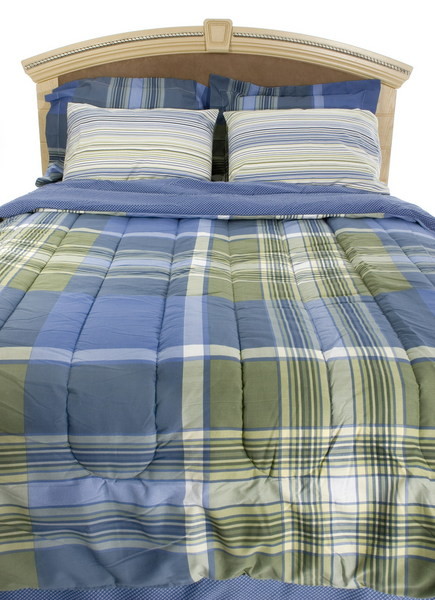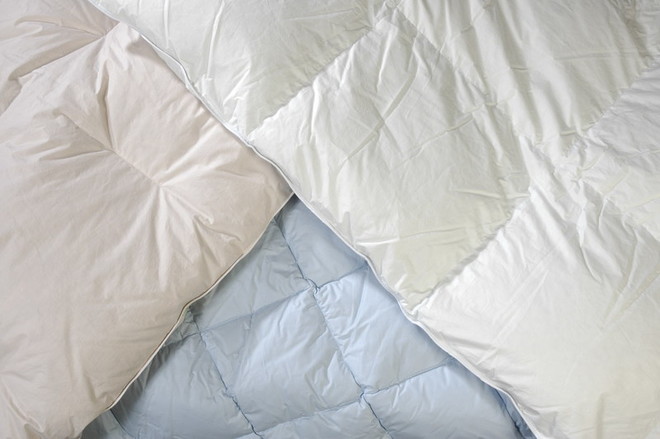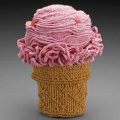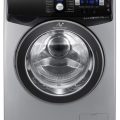Feather and downDown and feather of waterfowl (ducks andgeese) - the most popular natural filler. It makes the blanket warm and very airy. The lightest models are made from the down of live birds. Cheap feather blankets (from 3,000 rubles) are usually heavy and short-lived, after a short time the feather begins to crawl out through the fabric. A quality blanket costs about 8 - 10,000 rubles. The down of a white goose or Icelandic duck is additionally treated with a composition against dust mites - these products can be used by asthmatics and allergy sufferers. However, such products can be washed out when washed. Care: Can be dry cleaned, but can also be washed at + 60 ° C, dry in a straightened form, periodically turning over and shaking the stuck down with your hands. Both pillows and blankets benefit from regular (at least once a month) airing in the fresh air. Feathers are not bad If the blanket contained only down, it would simply not hold its shape, but would “spread out” like a pancake. Even the most expensive blankets contain feathers (10%), which give the product elasticity, airiness and volume. However, low-quality blankets often contain coarse feathers - they are easy to recognize by touch. The optimal ratio is 60% down, 40% feathers. The higher the percentage of feathers in the blanket, the cheaper it is. Wool Warm blanketWool blankets are realDoctors! They have a healing effect, as they contain animal fat (lanolin). Wool blankets are irreplaceable for people suffering from osteochondrosis, rheumatism and colds. When in contact with the human body, wool can absorb up to 30% of moisture (sweat), while remaining dry to the touch. Moreover, as soon as you get out from under the blanket, it will begin to actively evaporate moisture. Therefore, wool blankets do not require additional drying. And finally, wool has a unique ability to self-clean (dirt is shaken off the wool fibers). Therefore, forget about frequent washing! Sheep wool In addition to the fact that sheep wool is warm and absorbs moisture well, it helps with radiculitis, arthritis and back pain. Ideal for those who suffer from insomnia. Sheepskin blankets are much lighter than wadded ones, and will be comfortable not only for an adult, but also for a child. In children's production, sheepskin is used, interwoven in a special way, so that wool and fluff do not come out of the blanket. However, be careful. Sheep wool can cause allergies in some children. This is the most budget option of all wool fillers. A sheepskin blanket costs from 3,000 rubles, from lamb down (such a blanket is less warm, but more delicate) - from 2,500 rubles. Care: it is better not to wash sheep wool blankets, dry cleaning will help to deal with stains. Sheep wool becomes matted over time, so turn the blanket over more often and air it in the fresh air. Goat wool (down) As a rule, the soft undercoat from the neck and chest of Kashmir sheep, which graze on the slopes of the Himalayas even in severe frosts, is used as a filler for blankets. These are the warmest, softest and lightest wool blankets. They perfectly relieve muscle tension, performing a micro massage. Only 100-200 g of down is collected from one goat per year, so such a blanket is not cheap. The minimum price is 12,000 rubles (children's - about 4,500 rubles). Care: Delicate wash. Camel wool A blanket made of camel wool is lighter than sheep's wool. Very warm, has healing properties. Due to the large amount of lanolin, it is recommended for those who have problems with the spine and joint diseases. The service life of a camel wool blanket is 6-7 years. Choose a model made of combed wool, since shorn wool will break through the pillowcase and prick. A blanket with open wool costs about 4,000 rubles, a quilted blanket: wool - from 2,500, down - from 3,500 rubles. Care: Delicate wash. Blankets purchased in specialized stores and having a certificate of conformity are covered only with natural cotton fabric. Most often, this is batiste, satin, cotton with the addition of lyocel. Synthetics
Warm blanketWool blankets are realDoctors! They have a healing effect, as they contain animal fat (lanolin). Wool blankets are irreplaceable for people suffering from osteochondrosis, rheumatism and colds. When in contact with the human body, wool can absorb up to 30% of moisture (sweat), while remaining dry to the touch. Moreover, as soon as you get out from under the blanket, it will begin to actively evaporate moisture. Therefore, wool blankets do not require additional drying. And finally, wool has a unique ability to self-clean (dirt is shaken off the wool fibers). Therefore, forget about frequent washing! Sheep wool In addition to the fact that sheep wool is warm and absorbs moisture well, it helps with radiculitis, arthritis and back pain. Ideal for those who suffer from insomnia. Sheepskin blankets are much lighter than wadded ones, and will be comfortable not only for an adult, but also for a child. In children's production, sheepskin is used, interwoven in a special way, so that wool and fluff do not come out of the blanket. However, be careful. Sheep wool can cause allergies in some children. This is the most budget option of all wool fillers. A sheepskin blanket costs from 3,000 rubles, from lamb down (such a blanket is less warm, but more delicate) - from 2,500 rubles. Care: it is better not to wash sheep wool blankets, dry cleaning will help to deal with stains. Sheep wool becomes matted over time, so turn the blanket over more often and air it in the fresh air. Goat wool (down) As a rule, the soft undercoat from the neck and chest of Kashmir sheep, which graze on the slopes of the Himalayas even in severe frosts, is used as a filler for blankets. These are the warmest, softest and lightest wool blankets. They perfectly relieve muscle tension, performing a micro massage. Only 100-200 g of down is collected from one goat per year, so such a blanket is not cheap. The minimum price is 12,000 rubles (children's - about 4,500 rubles). Care: Delicate wash. Camel wool A blanket made of camel wool is lighter than sheep's wool. Very warm, has healing properties. Due to the large amount of lanolin, it is recommended for those who have problems with the spine and joint diseases. The service life of a camel wool blanket is 6-7 years. Choose a model made of combed wool, since shorn wool will break through the pillowcase and prick. A blanket with open wool costs about 4,000 rubles, a quilted blanket: wool - from 2,500, down - from 3,500 rubles. Care: Delicate wash. Blankets purchased in specialized stores and having a certificate of conformity are covered only with natural cotton fabric. Most often, this is batiste, satin, cotton with the addition of lyocel. Synthetics Blanket with synthetic filling –the best choice for allergy sufferers. After all, unlike wool and fluff, dust mites do not like artificial filler. Sintepon Blankets made of sintepon are very light and cheap, but they do not guarantee you a quality sleep, because this artificial material does not allow air to pass through well: the body does not breathe, and under such a blanket during the heating season you will feel like in a bathhouse. Hollow fiber, comfortel Polyester of the new generation. Although it is more expensive than the same sintepon ones, it perfectly maintains the temperature regime, and weighs no more. A high-quality synthetic blanket breathes (of course, worse than natural fibers), does not electrify, does not accumulate dust and is easy to wash. A good quality product will cost no less than 3,000 rubles. Care: a blanket made of holofiber and comfortel can be safely washed in a machine, as well as sintepon. But the latter becomes stiffer over time from repeated washing. EiderdownThis is the most expensive, the most weightless and the warmest (even hot) filler. Its cost is equal to the cost of gold, because to get just 1 kg of down you need to pick about 60 nests (!). The cover is made of silk - the finest fabric allows the blanket to take the shape of the body as much as possible. A blanket made of 100% eiderdown costs from 5,000 euros. Blankets with "open" wool are very popular now. Soft and fluffy blankets "with fur outside" are pleasant to use as a blanket. Falling asleep wrapped in such a blanket is a pleasure! Cotton wool An environmentally friendly filler that retains heat well, absorbs moisture and does not cause allergies. The disadvantages of a cotton blanket are its weight and ability to absorb various odors. Although some people simply cannot fall asleep unless they are pressed down with a thick "grandmother's" blanket. It's a matter of habit! Care: it does not like washing (the cotton wool gets lumped together) or dry cleaning (it leaves streaks). All that remains is to regularly air out the cotton blanket and dry it in the sun. Old blankets can be vacuumed and beaten out of dust outside. However, it is better to think about your health and finally say goodbye to this unwieldy and rather dubious inheritance.
Blanket with synthetic filling –the best choice for allergy sufferers. After all, unlike wool and fluff, dust mites do not like artificial filler. Sintepon Blankets made of sintepon are very light and cheap, but they do not guarantee you a quality sleep, because this artificial material does not allow air to pass through well: the body does not breathe, and under such a blanket during the heating season you will feel like in a bathhouse. Hollow fiber, comfortel Polyester of the new generation. Although it is more expensive than the same sintepon ones, it perfectly maintains the temperature regime, and weighs no more. A high-quality synthetic blanket breathes (of course, worse than natural fibers), does not electrify, does not accumulate dust and is easy to wash. A good quality product will cost no less than 3,000 rubles. Care: a blanket made of holofiber and comfortel can be safely washed in a machine, as well as sintepon. But the latter becomes stiffer over time from repeated washing. EiderdownThis is the most expensive, the most weightless and the warmest (even hot) filler. Its cost is equal to the cost of gold, because to get just 1 kg of down you need to pick about 60 nests (!). The cover is made of silk - the finest fabric allows the blanket to take the shape of the body as much as possible. A blanket made of 100% eiderdown costs from 5,000 euros. Blankets with "open" wool are very popular now. Soft and fluffy blankets "with fur outside" are pleasant to use as a blanket. Falling asleep wrapped in such a blanket is a pleasure! Cotton wool An environmentally friendly filler that retains heat well, absorbs moisture and does not cause allergies. The disadvantages of a cotton blanket are its weight and ability to absorb various odors. Although some people simply cannot fall asleep unless they are pressed down with a thick "grandmother's" blanket. It's a matter of habit! Care: it does not like washing (the cotton wool gets lumped together) or dry cleaning (it leaves streaks). All that remains is to regularly air out the cotton blanket and dry it in the sun. Old blankets can be vacuumed and beaten out of dust outside. However, it is better to think about your health and finally say goodbye to this unwieldy and rather dubious inheritance.

Making Money with Desserts: Success Stories
Evgeniya Polischuk (Fedutinova) instagram:@evgeniyafedutinovavk.com/janeshomebaking– It all started with baking for family and friends. Gradually, I started posting photos of my baked goods on Instagram – and orders started coming in. I made my first custom-made cake on October 13, 2014, and a little earlier I started making macaroons and cupcakes. You could say that the business “found me”, I am very […]

Soups are cold recipes with photos
Cold cucumber soup with yogurt and lemonsorbet from the chef of the restaurant La Taverna Alexander Zhurkin Photo: Getty Images Ingredients: Plain yoghurt – 125 g Cucumber – 150 g Lemon/lime sorbet – 50 g Cocktail shrimp – 24 g Fresh ginger juice – 1 g Lime juice – 5 g Fresh orange juice – 5 g Parsley – 1 g Pink pepper – 1 g Watercress – […]

barbeque kebab
Pork tenderloin in glaze Photo:Dmitry Bayrak/dbstudioPreparation time: 20 minutes + marinating time.Calories: 454 kcal per serving.For 4 servings: 4 pork tenderloins (approximately 300 g each), 1 onion, 2 cloves of garlic, 1 tsp. lemon zest, 1 tsp. lemon juice, a pinch of ground cumin, coriander and turmeric, 1 tbsp. vegetable […]

Pierre Duacan: dietary recipes: Ducane diet
Beetroot soup Photo:Season’S, Luxury Hotels RepresentationYou will need:· Boiled beetroot – 60 g· Fresh cucumbers – 20 g· Red radish – 20 g· Green onions – 10 g· Egg – 1 pc.· Drinking mineral water – 200 g· Salt – 1 gPreparation:· Boil the egg and beetroot.· Grate the cucumbers, radish and part of the beetroot. Put everything […]





